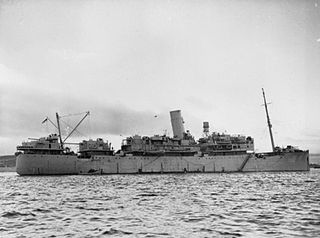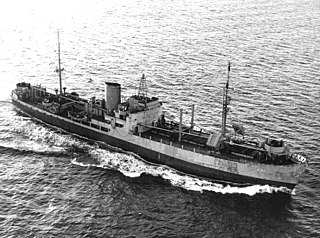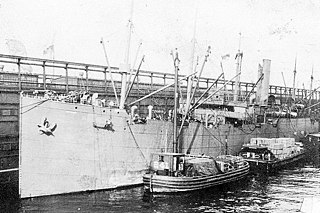
HMS Cheshire was a passenger ship that was built in Scotland in 1927 and scrapped in Wales in 1957. She belonged to Bibby Line, which ran passenger and cargo services between Rangoon in Burma and various ports in Great Britain, via the Suez Canal and Gibraltar. The Admiralty requisitioned her in 1939 and had her converted into an armed merchant cruiser (AMC). She was converted into a troopship in 1943, and returned to civilian service in 1948.

USS Susan B. Anthony (AP-72) was a turbo-electric ocean liner, Santa Clara, of the Grace Steamship Company that was built in 1930. Santa Clara was turned over to the War Shipping Administration (WSA) on 28 February 1942 and operated by Grace Lines as agent for WSA as a troop ship making voyages to the South Pacific. The ship was chartered to the Navy on 7 August 1942 for operation as a United States Navy transport ship. The ship was sunk 7 June 1944 off Normandy by a mine while cruising through a swept channel with all 2,689 people aboard being saved.

SS Absaroka was a steamer, named after the Absaroka Range of mountains in Montana and Wyoming, completed in February 1918 for the United States Shipping Board (USSB) which briefly operated the ship. From 17 September 1918 to 4 March 1919 the ship was commissioned as USS Absaroka with the identification number IX-2581 in United States Navy and operated by the Naval Overseas Transportation Service.

USS Arthur Middleton (AP-55/APA-25) was the lead ship of the Arthur Middleton-class attack transports and was in service with the United States Navy from 1942 to 1946. She was named for Founding Father Arthur Middleton and was scrapped in 1973.

Coastal trading vessels, also known as coasters or skoots, are shallow-hulled merchant ships used for transporting cargo along a coastline. Their shallow hulls mean that they can get through reefs where deeper-hulled seagoing ships usually cannot, but as a result they are not optimized for the large waves found on the open ocean. Coasters can load and unload cargo in shallow ports. For European inland waterways, they are limited to a 33,49 m beam.

USS Algorab (AKA-8) was laid down as Mormacwren, one of the earliest Maritime Commission-type C2 ships, on 10 August 1938 by the Sun Shipbuilding & Drydock Co., Chester, Pennsylvania as hull 177 for Moore-McCormack. Mormacwren was acquired by the United States Navy 6 June 1941, commissioned 15 June 1941 as USS Algorab (AK-25) and was redesignated an attack transport on 1 February 1943 with the hull number chanted to AKA-8. Algorab decommissioned on 3 December 1945 and was delivered to the Maritime Commission on 30 June 1946 for disposal, purchased by Wallem & Co. on 4 April 1947 for commercial service.

USS Pontiac (AF-20) was the Danish refrigerated cargo ship Australian Reefer that sought refuge in the neutral United States when Germany occupied Denmark in April 1940. In 1941 the United States seized 40 Danish ships idle in its ports with Australian Reefer being among those ships.

SS Munargo was a commercial cargo and passenger ship built for the Munson Steamship Line by New York Shipbuilding Corp., Camden, New Jersey launched 17 September 1921. Munargo operated for the line in the New York-Bahamas-Cuba-Miami service passenger cargo trade. In June 1930 the United States and Mexican soccer teams took passage aboard Munargo from New York to Uruguay for the 1930 FIFA World Cup. The ship was acquired by the War Shipping Administration and immediately purchased by the War Department for service as a troop carrier during World War II. Shortly after acquisition the War Department transferred the ship to the U.S. Navy which commissioned the ship USS Munargo (AP-20). She operated in the Atlantic Ocean for the Navy until returned to the War Department in 1943 for conversion into the Hospital ship USAHS Thistle.
MS Tunis was a Danish motor ship in commercial service for Det Forenede Dampskibs Selskab (DFDS), Copenhagen, Denmark, as a cargo ship delivered to DFDS on 15 January 1936. Tunis was the first of four sister ships, two built in 1936 and two in 1938, that operated for DFDS. The ship's normal service was Copenhagen to the Mediterranean until war in Europe when all four of the ships were put into Atlantic service.

USS Briareus was originally the cargo ship SS Hawaiian Planter laid down as a Maritime Commission type C3 Mod. at Newport News, Virginia, by the Newport News Shipbuilding & Dry Dock Company for the Matson Line and delivered 15 May 1941. After a brief pre-war commercial service and allocation to the Army for transport the ship was purchased by the United States Navy in February 1943 and converted to a repair ship.

USS Crescent City (AP-40/APA-21) was the lead ship of the Crescent City-class attack transports that served with the US Navy during World War II. The ship was built as the cargo and passenger liner Delorleans for the Mississippi Shipping Company's Delta Line. After brief commercial operation the ship was among 28 vessels requisitioned in June 1941 for the Navy and the Army. The Navy renamed the ship Crescent City, a popular nickname for New Orleans, Louisiana, upon commissioning 10 October 1941. The ship was decommissioned and laid up in 1948 before being loaned to the California Maritime Academy to serve as a training ship 1971–1995 and then transferred to a foundation in a failed art colony project. The ship left California for Texas scrapping in 2012.

USS George F. Elliott (AP-105) was a cargo liner built for the Mississippi Shipping Company as SS Delbrasil for operation between New Orleans and the east coast of South America in 1939 by its operator, Delta Line. The ship entered that service and operated until taken over by the War Shipping Administration (WSA) on 28 April 1942 for operation by Delta Line acting as WSA's agent. On 25 August 1943 WSA allocated the ship to the Navy for conversion to a troop transport commissioned and operated by the Navy for the duration of the war. Ownership of the ship was transferred from Mississippi Shipping to WSA on 4 February 1944 while under Navy operation and was retained until sale to American South African Lines on 22 December 1948. The ship was renamed African Endeavor until returned as a trade in to the Maritime Commission on 22 September 1960 for layup in the James River reserve fleet and later sold to Boston Metals for scrapping.

Empire Bittern was a steamship, built as a livestock-carrying cargo ship in 1902 at Belfast, Ireland as Iowa for the White Diamond Steamship Company Ltd of Liverpool. The ship was sold to the Hamburg America Line and renamed Bohemia in 1913.
SS Fairport was a Type C2-S-E1 cargo ship built by Gulf Shipbuilding for the Waterman Steamship Company. She was sunk by U-161 on 16 July 1942. All hands were rescued by an American destroyer.

USAHS Acadia was the first United States Army Hospital Ship in World War II. Built in 1932 by Newport News Shipbuilding as a civilian passenger/cargo ocean liner for the Eastern Steamship Lines, the ship was in US coastal and Caribbean service prior to its acquisition by the US Maritime Administration in 1941.

MS Sea Witch was a United States Maritime Commission type C2 cargo ship, the first of four pre-war hulls, built by Tampa Shipbuilding & Engineering Company, Tampa, Florida and delivered in July 1940. The ship was of the basic C2 design, rather than the more numerous C2-S, C2-S-A1, C2-S-B1 types and four C2-T hulls delivered December 1941 through March 1942. Sea Witch was one of the relatively few C2 types built with diesel engines.
Athos II was a passenger and cargo liner for Compagnie des Messageries Maritimes making her maiden voyage from Marseilles 25 March 1927 starting on the line's Far East service serving Marseilles, Malaya, Indo-China, Hong Kong, Shanghai, Kobe and Yokohama. The ship, laid down in 1923 and launched 12 November 1925, had been completed by Aktien-Gesellschaft „Weser", Bremen and delivered to the French as part of World War I reparations. After a 1937 refit, including boilers increasing speed to 19 knots, Athos II resumed Far East service.

The SS Harry Luckenbach, built as a cargo ship ordered by the Luckenbach Steamship Company and built at Sun Shipbuilding and Drydock Co. in Chester, Pennsylvania in 1919. The as yet unnamed ship was requisitioned by the United States Shipping Board (USSB) before completion and converted to a troop transport. The USSB allocated the ship, which had been fitted out with temporary troop accommodation in its cargo spaces, to the Navy which commissioned the ship on 7 July 1919 as USS Sol Navis with the Identification number 4031A. The ship was decommissioned October 1919 after two trips to France.
MS Cape Flattery was a United States Maritime Commission type C1-B cargo ship built in 1940–41 by the Seattle-Tacoma Shipbuilding, Tacoma, Washington, for the commission to be assigned to the American Mail Line for transpacific service. After the United States entry into the war the ship was operated by the War Shipping Administration (WSA) through American Mail as agents. The ship, after about a year of operation, became a troop transport for the remainder of the war.

MS Torrens was a Norwegian cargo motor ship built in 1939 by Kockums Mek.Verksted AB., Malmö, Sweden, for Wilhelm Wilhelmsen, Tønsberg, Norway. In 1940, after the German invasion of Norway, the ship operated for the Norwegian Shipping and Trade Mission (Nortraship) in London. Voyages in early 1940 involved U.S. Atlantic ports and the Philippines, China and Japan. By mid 1940 the operations tended to be out of U.S. Pacific coast ports, with occasional visits to the Atlantic, to the same destinations. The same pattern repeated in 1941.















